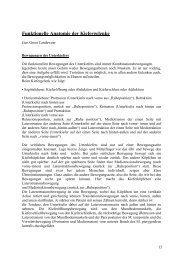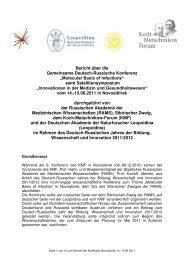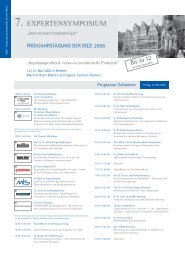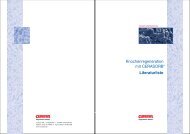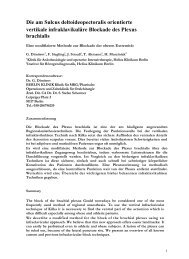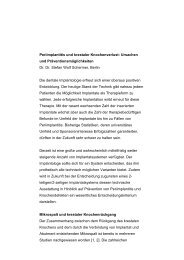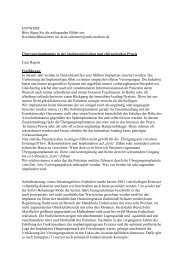NEWSLETTER AKFOS (2008) Jahr 15: No.1 - Berlin Klinik
NEWSLETTER AKFOS (2008) Jahr 15: No.1 - Berlin Klinik
NEWSLETTER AKFOS (2008) Jahr 15: No.1 - Berlin Klinik
Erfolgreiche ePaper selbst erstellen
Machen Sie aus Ihren PDF Publikationen ein blätterbares Flipbook mit unserer einzigartigen Google optimierten e-Paper Software.
Mortinger 1989, Lauridson and Myers 1993). The anatomic situation normally allows<br />
a correct differentiation between a human and an animal bite. Especially dog bites<br />
are easy to identify. As a matter of course, the differentiation of dog races is<br />
problematic. Inhülsen (1991) reported a case of murder with patterned injuries of a<br />
dog. It was impossible to differentiate between a Rottweiler and a German shepherd.<br />
Ligthelm und van Niekerk (1994) presented two cases of dog bites. They had the<br />
distinction of being spread over the entire body which is rather unusual in cases of<br />
human bite marks.<br />
Guidelines for the analysis of bite marks o are important for the investigation and<br />
should be respected. To standardize the analysis of bite marks the American Board of<br />
Forensic Odontostomatology (ABFO) established the following guidelines in 1986:<br />
1. History – Obtain a thorough history of any dental treatment carried out after<br />
the suspected date of the bite mark.<br />
2. Photography – Extra-oral photographs including full face and profile views,<br />
intra-orals should include frontal views, two lateral views and an occlusal view<br />
of each arch. Often it’s useful to include a photograph of maximal mouth<br />
opening. If inanimate materials, such as foodstuffs, are used for test bites the<br />
results should be preserved photographically.<br />
3. Extra-oral examination – Record and observe soft tissue and hard tissue<br />
factors that may influence biting dynamics. Measurements of maximal opening<br />
and any deviations on opening or closing should be made.<br />
4. Intra-oral examination – Salivary swabs should be taken. The tongue should<br />
be examined to assess size and function. The periodontal status should be<br />
noted with particular reference to mobility. Prepare a dental chart if possible.<br />
5. Impressions – Take two impressions of each arch using material that meet the<br />
American Dental Association specifications. The occlusal relationship should be<br />
recorded.<br />
6. Sample bites – Whenever possible, sample bites should be made into an<br />
appropriate material, simulating the type of bite under study.<br />
7. Study casts – Casts should be prepared using Type II stone. Additional casts<br />
should be made by duplicating the master casts.<br />
These guidelines should be obeyed in routine case work. Pretty aund Sweet (2001c)<br />
sent out a questionnaire to 69 American odontologists examining bite marks. The<br />
purpose was to examine the adherence to the guidelines. 28 (41%) of the<br />
odontologists were members of the ASFO (American Society of Forensic Odontology).<br />
The authors found that the methods differ between the examiners. However, in<br />
general the odontologists adhere to the guidelines. The materials employed by the<br />
odontologists were acceptable and defendable in court. Forensic dentists who neglect<br />
the guidelines could face harsh criticism when testifying in court (Pretty and Sweet<br />
2001d). Pretty und Turnbull (2001) reported about a lack of dental uniqueness<br />
between two suspects. The dental arrangement of the suspects was similar and it<br />
was impossible to determine the biter positively. Thus, the central dogma that every<br />
bite mark is unique, was disproved.<br />
In another study the effectiveness of digital bite mark overlays was verified. Different<br />
examiners were asked to compare scanned photos of bite marks with impressions of<br />
suspects. Pretty and Sweet (2001b) found that the experience of the examiners has<br />
an influence on the results, however, the method has a high level of reliability.<br />
Using patterns of the study casts of a suspect and fixation of the bite registration are<br />
the basis for a successful analysis (Endris 1979). Impressions in similar material<br />
29



